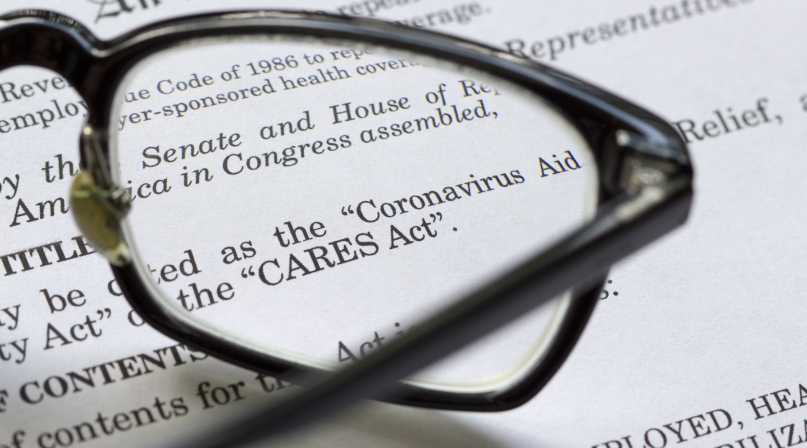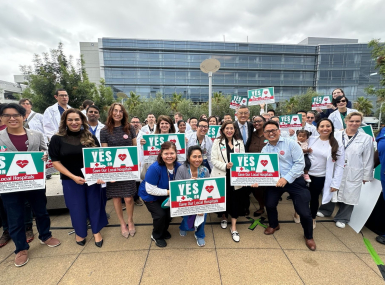HHS issues termination notices for health grant funding
Author

Blaire Bryant

Naomi Freel
Upcoming Events
Related News

Key Takeaways
On March 25, the U.S. Department of Health and Human Services (HHS) sent letters to state authorities and counties with direct grant funding announcing the immediate termination of several pandemic-related grants, which was previously set to run through September 2025. While HHS has not made an official announcement about the grant terminations, impacted states and counties have begun reporting that they received individual notifications. States and other grant recipients should check their grants portal for specifics on which grants were terminated. Grantees have 30 days from the grant termination to submit final financial reports.
Background
During the COVID-19 pandemic, Congress made major investments in public health to address the immediate crisis and strengthen long-term public health readiness. These investments were not tied to the federal public health emergency declaration. The investments included:
- Coronavirus Preparedness and Response Supplemental Appropriations Act, 2020 (P.L. 116–123): Congress provided $8.3 billion in funding, which included $2.2 billion in public health funding, $1 billion of which was a set-aside for State and Local Public Health Emergency Preparedness (PHEP) grants to support states, counties, cities and tribes.
- The Coronavirus Aid, Relief, and Economic Security Act (CARES Act; P.L. 116-136): Congress provided $2.1 trillion in funding and allocated $2.45 billion for public health grants to states and localities.
- Paycheck Protection and Health Care Enhancement Act (P.L. 116–139): Congress provided $483 billion in funding and appropriated $25 billion for various federal agencies and state and local governments to increase COVID-19 testing capacity.
- The Coronavirus Response and Relief Supplemental Appropriations Act, 2021 (CRRSA, P.L. 116-260): Congress provided $900 billion in funding with $22.4 billion directed to be sent to states, localities, territories, tribes and tribal organizations for testing, contract tracing, surveillance, containment and mitigation to prevent the spread of COVID-19.
- American Rescue Plan Act, 2021 (ARPA; P.L. 117-02): Congress provided $1.9 trillion in funding, which included investments in genome sequencing, vaccine confidence, and support for community and teaching health centers, as well as $3 billion in mental health and substance use block grants to be used over five years.
HHS used these supplemental appropriations to offer various grants and cooperative agreements to states, counties and other local jurisdictions.
Terminated grants
Note: This grant list is not exhaustive and includes only the grant terminations that have been shared with NACo at the time of publishing.
The terminated grants provided critical funding for various public health initiatives during and following the COVID-19 pandemic. Below is an overview of each affected grant:
- Epidemiology and Laboratory Capacity for Prevention and Control of Emerging Infectious Diseases (ELC) Cooperative Agreement: This program supports state and local health departments in detecting, preventing and responding to emerging infectious diseases. It provides funding and technical assistance to strengthen public health infrastructure and enhance the nation's ability to address infectious disease threats.
- National Initiative to Address COVID-19 Health Disparities Among Populations at High-Risk and Underserved, Including Racial and Ethnic Minority Populations and Rural Communities: This grant provides funding to state and local health departments to improve testing, contact tracing and other COVID-19 response efforts in high-risk and underserved communities, including racial and ethnic minorities and rural populations. It aims to reduce COVID-19-related health disparities and strengthen public health capacity.
- Community Mental Health Services Block Grant (MHBG) Supplement Grants: The program helps fund comprehensive community mental health services by providing funding for expanded mental health services, crisis response and community-based treatment programs. Administered by SAMHSA, it supports flexible use of funds for new or existing programs and provides technical assistance to ensure the use of evidence-based practices.
- Substance Use Prevention, Treatment and Recovery Services (SUPTRS) Supplement Grants: This grant (previously the Substance Abuse Prevention and Treatment Block (SABG)) funds state and local efforts to prevent and treat substance use disorders. Administered by SAMHSA, the program supports prevention strategies, treatment services and recovery supports, with a focus on high-risk populations such as pregnant women, individuals with HIV/AIDS and injection drug users.
- Community Health Workers for COVID Response and Resilience: This initiative expanded the presence of trained community health workers (CHWs) in the communities most affected by COVID-19. CHWs helped prevent the spread of COVID-19, connect residents to health and social services and strengthen community resilience for future public health emergencies.
Some rescinded grants, including the MHBG and SUPTRS, were not directly tied to COVID-19 mitigation. The American Rescue Plan Act allocated $1.5 billion to each, with spending originally allowed through September 30, 2025. Now, with the deadline moved up by six months, an estimated $1 billion in behavioral health funding could be lost. While COVID-19 cases have declined, behavioral health needs have remained steady since the pandemic, making this funding more critical than ever.
Impacts on counties
The sudden termination of these grants poses a significant threat to the stability of local public health and behavioral health systems. Counties rely heavily on this funding to operate essential programs that support community well-being, especially in the wake of the COVID-19 pandemic. Without it, core services like 988 crisis call centers, local substance use prevention efforts, and community health worker initiatives could be scaled back or eliminated entirely. Access to life-saving tools such as fentanyl test strips may be reduced, just as overdose rates remain high in many regions.
Emergency response systems may also feel the strain, with fewer resources for EMS teams responding to mental health crises and peer-run recovery centers that offer critical support to individuals in recovery. Public health infrastructure—already stretched thin—could face cuts to immunization programs and laboratory capacity, undermining efforts to manage both emerging and ongoing health challenges. As counties continue to serve on the front lines of America’s health crisis, these funding cuts risk unraveling the local safety nets that have become essential to community resilience and recovery.
Next steps
A federal judge has temporarily blocked the Trump administration from cutting billions in federal funds that are currently providing ongoing support for COVID-19 and public health initiatives, following a lawsuit by 23 states and D.C. To better understand the full impact of these grant terminations, NACo is collecting information from counties on how these cuts are affecting local programs and services. If your county has experienced a termination of direct grant funding or funding that is passed through from your state, we encourage you to complete our survey. Your responses will help NACo create a more comprehensive picture of these funding losses, support county partners in navigating the changes and strengthen our advocacy efforts.
Resource
Federal Reforms to Medicaid Financing: What Counties Should Know

Related News

CMS issues new guidance on Medicaid Community Engagement Requirements
On December 8, the Centers for Medicare & Medicaid Services (CMS) released a Medicaid and CHIP Services Informational Bulletin (CIB) directing states on how to implement the Medicaid community engagement requirements enacted under Section 71119 of the One Big Beautiful Bill Act legislation (Public Law 119-21), or H.R. 1.

California county sales tax measure backfills federal healthcare cuts
Santa Clara County, Calif. will raise an estimated $330 million each year from a sales tax to backfill lose Medicaid funding.
